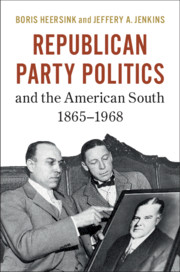Book contents
- Republican Party Politics and the American South, 1865–1968
- Republican Party Politics and the American South, 1865–1968
- Copyright page
- Contents
- Tables
- Figures
- Preface
- 1 Introduction
- 2 The Republican Party and the South: Some Preliminaries
- Part I The South and National Republican Party Politics, 1865–1968
- Photos
- Part II Southern Republican Party Politics at the State Level
- Index
1 - Introduction
Published online by Cambridge University Press: 06 March 2020
- Republican Party Politics and the American South, 1865–1968
- Republican Party Politics and the American South, 1865–1968
- Copyright page
- Contents
- Tables
- Figures
- Preface
- 1 Introduction
- 2 The Republican Party and the South: Some Preliminaries
- Part I The South and National Republican Party Politics, 1865–1968
- Photos
- Part II Southern Republican Party Politics at the State Level
- Index
Summary
What role did the Republican Party play in the South before the mid-1960s? On the national side, Republican presidents and presidential candidates engaged in near continuous attempts at winning Southern states. In addition, a number of Republican presidents – including Hayes, Arthur, Harrison, Harding, Hoover, and Eisenhower – invested significantly (though, most often unsuccessfully) in rebuilding local party organizations in the South. Importantly, we show that every single Republican president between Grant and Nixon relied on some form of a “Southern strategy” aimed at winning (re-)nomination at the national convention and/or strengthening state party organizations in the South. This corrects a misconception in various historical accounts that Republican presidents effectively gave up on the South by the early twentieth century. At the state level, executive (federal) patronage, and the considerable profits that could be gained from controlling it, inspired frequent contestation over control of the local party organizations. That is, while many Republican state parties no longer functioned as regular political parties – often failing to even run candidates in state elections – control of the state party organizations continued to be valuable to local party elites. Initially, these contests largely involved different mixed-race groups surrounding (former) elected officials and federal office-holders. But over time, contests began to take on an increasingly racial hue, as Black-and-Tans (a faction of black and white Republicans) vied for control with Lily-Whites (a faction of white Republicans that sought to ban blacks from leadership positions in the party).
- Type
- Chapter
- Information
- Publisher: Cambridge University PressPrint publication year: 2020

